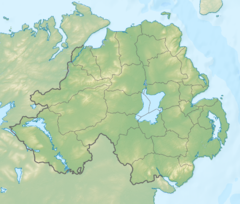| Location | Portbraddon, County Antrim |
|---|---|
| Region | Northern Ireland |
| Coordinates | 55°14′54″N 6°28′32″W / 55.24833°N 6.47556°W |
| Type | sea cave |
| History | |
| Periods | Mesolithic |
| Site notes | |
| Excavation dates | 1930s |
| Archaeologists | Andrew McLean May |
Portbraddon Cave (also spelled Portbradden, Portbraddan) is a relict sea cave located near Portbraddon, County Antrim on the north coast of Northern Ireland. Its location 5 m (16 ft) above the present-day high water mark makes it important archaeologically, as it would have been inhabited as far back as the Mesolithic.[1]
In the 1930s the cave was the subject of an archaeological dig by Andrew McLean May, who made a number of notable finds. During the course of the excavations, which went as deep as 2 m (7 ft) below the modern floor level, May encountered: iron objects, including the barrel of a muzzle-loading pistol; pottery and flint tools, some of which showed Mesolithic characteristics; fireplaces and animal bones and ultimately the original water-worn floor of the cave. Most notably May also discovered partial remains of three human females.[1] They were examined by Professor Thomas Walmsley at Queen's University Belfast, who noted that "most of the bones have primitive features which are not likely found together in post-medieval time; and there are some characteristics which suggest an epi-palaeolithic inheritance."[2]
The whereabouts of the human bones have since become unknown, and they have not been subjected to modern radiocarbon dating techniques.[1]
See also
References
- ^ a b c McInroy, Andy. "Chapter 7: The Caves of Prehistoric Man, Whitepark Bay". Great Sea Caves of Antrim. Retrieved 7 November 2011.
- ^ McInroy, Andy. "Chapter 7: The Caves of Prehistoric Man, Whitepark Bay". Great Sea Caves of Antrim. Retrieved 7 November 2011.
Originally published: May, Andrew McLean (1943). "Portbraddan Cave, County Antrim". Ulster Journal of Archaeology. 3. VI: 39–61.


